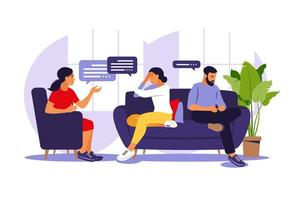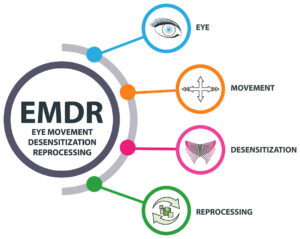Remember when we were kids, colours made us happy; they used to bring a big smile on our innocent faces. We enjoyed our music, dance, and art classes a lot. During classes, we packed our bags in happiness that for an hour we would paint our hearts out, sing with our friends, and dance with friends to our favourite songs.
We gradually began to lose sight of the importance of art in our lives as we grew older and became more susceptible to materialistic items. Stress became our closest friend, making us more vulnerable to deteriorating mental wellbeing. The one-stop shop for reinstating creativity and bringing colour, beats, and rhythms into our lives is art therapy counselling.
Besides merely drawing and painting, art therapy counselling incorporates expression therapy, dance, theatre, ceramics, sculpting, and writing. The true essence of art therapy counselling is to utilise an individual’s creativity to aid in self-exploration, self-efficacy, and expressing themselves through their chosen art.
The sense of accomplishment we get when we engage in art is tremendous; there is a natural rush of endorphins that makes us happy and helps us remove the sense of worthlessness; it boosts our self-esteem, and we are naturally smiling and satisfied within ourselves. Art therapy counselling caters to a wide range of populations, including individuals who find themselves worthless, struggling with stress disorders, anxiety disorders, ageing-related disorders, psychological symptoms associated with other medical conditions, depression, eating disorders, and many more.
According to a 2016 study published in “Journal of the American Art Therapy Association,” less than one hour of creativity helps in reducing stress and has a positive effect on our mental health, regardless of our artistic talents.” From our hectic schedules, let’s try to take out 30-45 minutes for yourself and cherish the sweet juice of art therapy counselling.
Art therapy is not the same as a dance, music, or art lesson. While the latter are expert classes with the primary goal of familiarising people with the procedures and approaches of a certain art form, art therapy is simply a way of expressing ourselves via the use of paint, music, dance, theatre, and writing. We do not need any artistic abilities to engage in art therapy counselling. Art therapy counselling is a soft and warm place where we can paint the canvas however we can; it’s a place where we can sing no matter how badly we sing; we can dance when we don’t know any hook steps; and we can weave our words into poetry when we aren’t really poets.
Art therapy counselling techniques
Art therapy is a broad field that encompasses a wide range of techniques. Here is the list of the most commonly used techniques used in art therapy counselling.
- Doodling and scribbling
- Mandala art
- Finger printing
- Photography
- Painting
- Sculpting
- Working with clay
- Colouring
- Collage making
- Poetry recitation
An efficient technique to aid people in exploring deeply into the process of self-discovery is art therapy counselling. It assists with understanding our true selves, what offers us joy, and how to relax and recover from difficult situations. It also helps us practise mindfulness, control our negative emotions, and become compassionate. With the fast-paced lifestyle of the twenty-first century, it helps us balance our personal and professional lives and improve our quality of life.
Art therapy counselling aids significantly in dealing with conflicts related to stress, post-traumatic stress, addressing children with learning disabilities, and resolving emotional conflicts.
We humans are social beings, and in the race of socialising we tend to forget ourselves, and we get absorbed by undesirable thoughts, emotional upheaval, a loss of self-awareness, and shame. We seek pleasure externally, which is generally temporary, and forget to be with ourselves.
Art therapy counselling provides us a way where we can connect with ourselves with not much conversation with a therapist but more with ourselves using colours, music, dance, and drama. It is a safe place where the therapist guides us, acts as a constant motivator, and aids in our journey toward a happier and improved quality of life.
Let us all get out of shame of not knowing or mastering any skill; let’s embrace ourselves and make ourselves know, “It is okay if we don’t know how to draw a flower or dance on beat; the best part is dancing without knowing the beats is fun and makes us happy. When we fill colours in a very abstract way, it makes us express ourselves and helps in breaking boundaries that we create for ourselves in our subconscious.” Let’s enjoy the joy of life filled with art around us, guiding us towards our betterment and our happier versions.
Why CoachForMind?
- Experienced Psychologists: We are a team of licensed RCI-registered clinical psychologists. Our team is well-experienced in various forms of therapy such as CBT, DBT, Narrative Therapy, and other therapeutic techniques such as art therapy counselling.
- Personalized Approach: We are dedicated to treating our clients in the best-suited way, carefully curated as per the client’s needs, and adhering to one-on-one, client-centered therapy.
- Scientific Techniques: Our treatment plans and therapeutic methods are based on highly researched scientific findings such as CBT, DBT, and Narrative Therapy among many other therapeutic techniques used in art therapy counselling.
- Quality service: We at CoachForMind ensure quality services in our treatment regime and therapeutic approaches. Our clients hold most value to us, so we ground our techniques in empathy while maintaining professionalism.
For more information, please visit our website or contact us directly at coachformind@gmail.com





